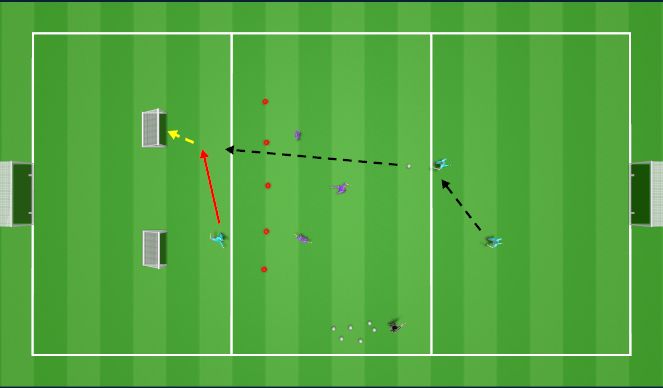Football/Soccer Session (Academy Sessions): Game Principles task -Passing - Breaking/Defending lines (Attacking and Defending SSG) (Start Time: 2025-06-16 20:05:00)

Profile Summary

| Name: | Graham Dyke |
|---|---|
| City: | Oswestry |
| Country: | United Kingdom |
| Membership: | Adult Member |
| Sport: | Football/Soccer |
Description
Organisation (Practice Layout & Transition)
Small sided games (E.g., 4 v 4) with a technical focus on passing and the breaking lines principle from both an attacking and defensive perspective.

See the guidance at the top of this page to understand why you are not seeing interactive Football/Soccer images.

Breaking Lines: Defending (55 mins)
Practice Focus: Passing – Breaking Lines (Defending in a Small-Sided Game)
Setup:
Divide the attacking half into thirds, marking off the final third as a restricted zone. Two goals at one end.
Attackers play 2 v 3 in the middle third, with one attacker positioned in the final third.
The defenders operate in the middle third only.
Objective:
The defending team's goal is to prevent the attackers from breaking their line with a through pass into the final third, where the attacker can then attempt to score in either of the two small goals.
Coaching Points:
Defensive Compactness:
Encourage defenders to stay tight and connected, minimizing passing lanes between them.Unit Cohesion:
Defenders should communicate and move as a unit to apply pressure while maintaining cover.Decision Making:
Players must judge when to press the ball carrier and when to delay, ensuring they don’t overcommit or open up gaps.Cover and Support:
While one defender engages the ball, the others should provide support and cover the space behind.
Adaptations (Progressions & Regressions):
Progressions
Reduce Defensive Numbers
Change to 2v2 in the middle third, making it harder for defenders to cover all passing lanes and increasing the need for tight positioning.
Add a Neutral Attacker in Midfield
Include a neutral player who supports the attacking team in the middle third, creating a 3v3+1. Forces defenders to manage more options and encourages quicker decision-making.
Timed Pass Through the Line
Require the attacking team to break the line within a set time limit (e.g., 10 seconds) to simulate pressure and encourage quicker build-up play.
Allow Final Third Attacker to Move Horizontally
Let the attacker in the final third move side to side, making it harder for defenders to predict and block the passing lane.
Two-Touch Limit for Attackers
Restrict the attacking players to two touches to speed up play and test defenders' reactions and positioning.
Counter-attack Option for Defenders
If defenders win the ball, allow them to counterattack into mini-goals or break into space to simulate transition moments.
Regressions
- Increase Defensive Numbers
Play 3v3 or 4v3 in the middle third to give defenders more support and improve their confidence with positioning.
Make Passing Lane Bigger
Widen the passing channel into the final third to give attackers more opportunities to succeed and help defenders recognize danger areas more clearly
No Pressure on First Pass
Start the game with attackers unopposed for the first 5 seconds to allow them to shape up and give defenders a clearer picture of how play might develop.









 Play animation
Play animation Play step-by-step
Play step-by-step Repeat (toggle)
Repeat (toggle) Full Screen
Full Screen Pause
Pause Stop
Stop
Breaking Lines: Attacking (80 mins)
Passing - Breaking lines (Attacking small sided game)
Objective:
The attacking team's goal is to score points by successfully passing the ball through between the lines of the defenders.
*Scoring system - 1 point for a line break / 2-points for line break resulting in a goal (see diagram).
Coaching Points:
Attacking players must demonstrate good decision-making to identify and exploit passing lanes.
Off-the-ball movement is essential—players should constantly adjust their positioning to find and stay in space.
Encourage players to remain aware of their surroundings, re-evaluating their positions to stay available for passes through or around the defenders.
Adaptations (Progressions & Regressions):
Regression 1: Set up a central zone on the pitch that defenders must stay within.
= This reduces pressure on the attacking team and gives them more time and space to build play.
Regression 2: Remove 1 player from a team (indicated by red arrow on the diagram for red team) to create an overload for the blue team - which should, in theory allow for greater success in breaking the lines due to increased space.
Progressions:
Timed Challenge: Give the attacking team a time limit (e.g., 10 seconds) to make a successful pass through the defensive line. Encourages quicker decision-making.